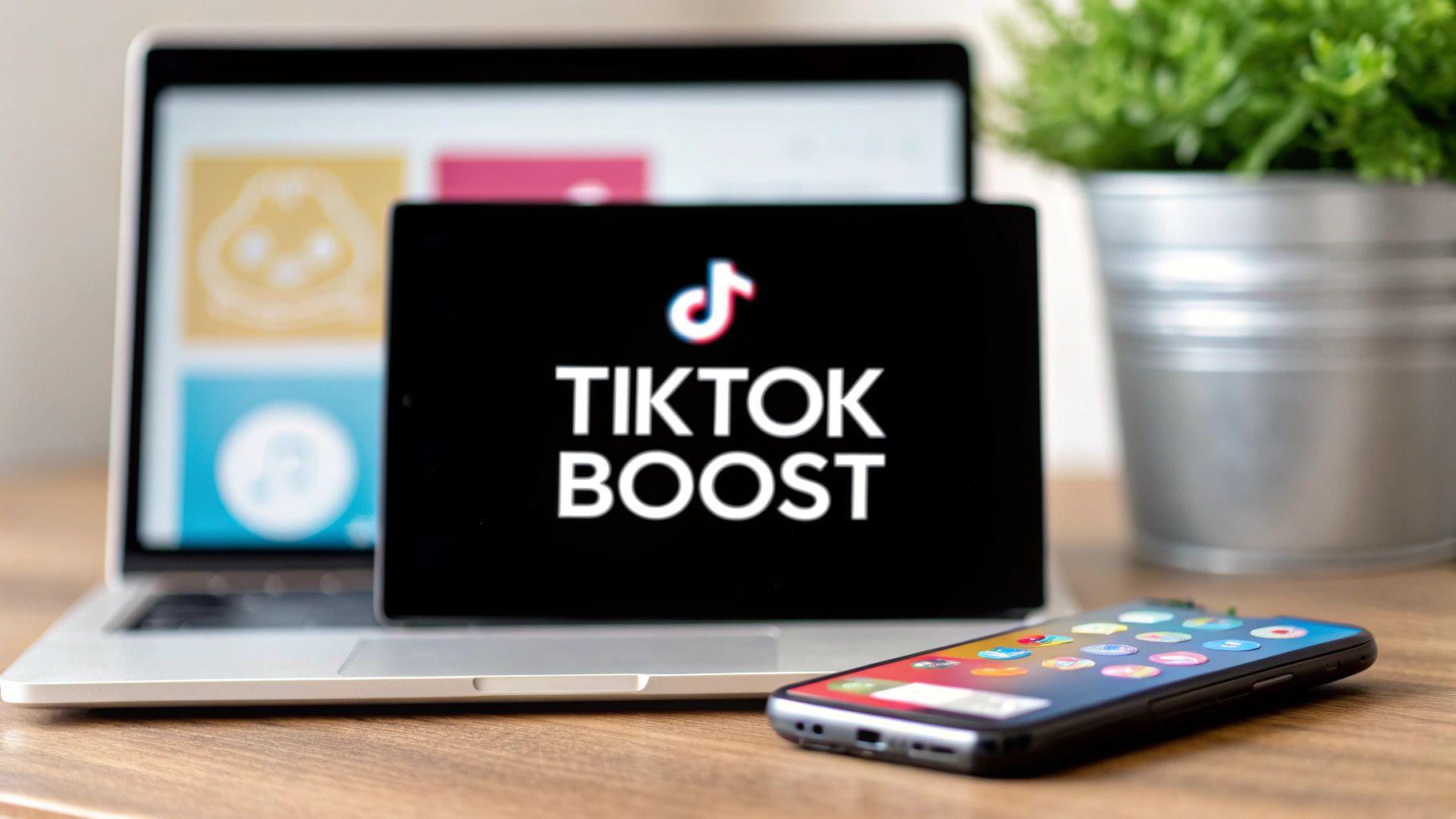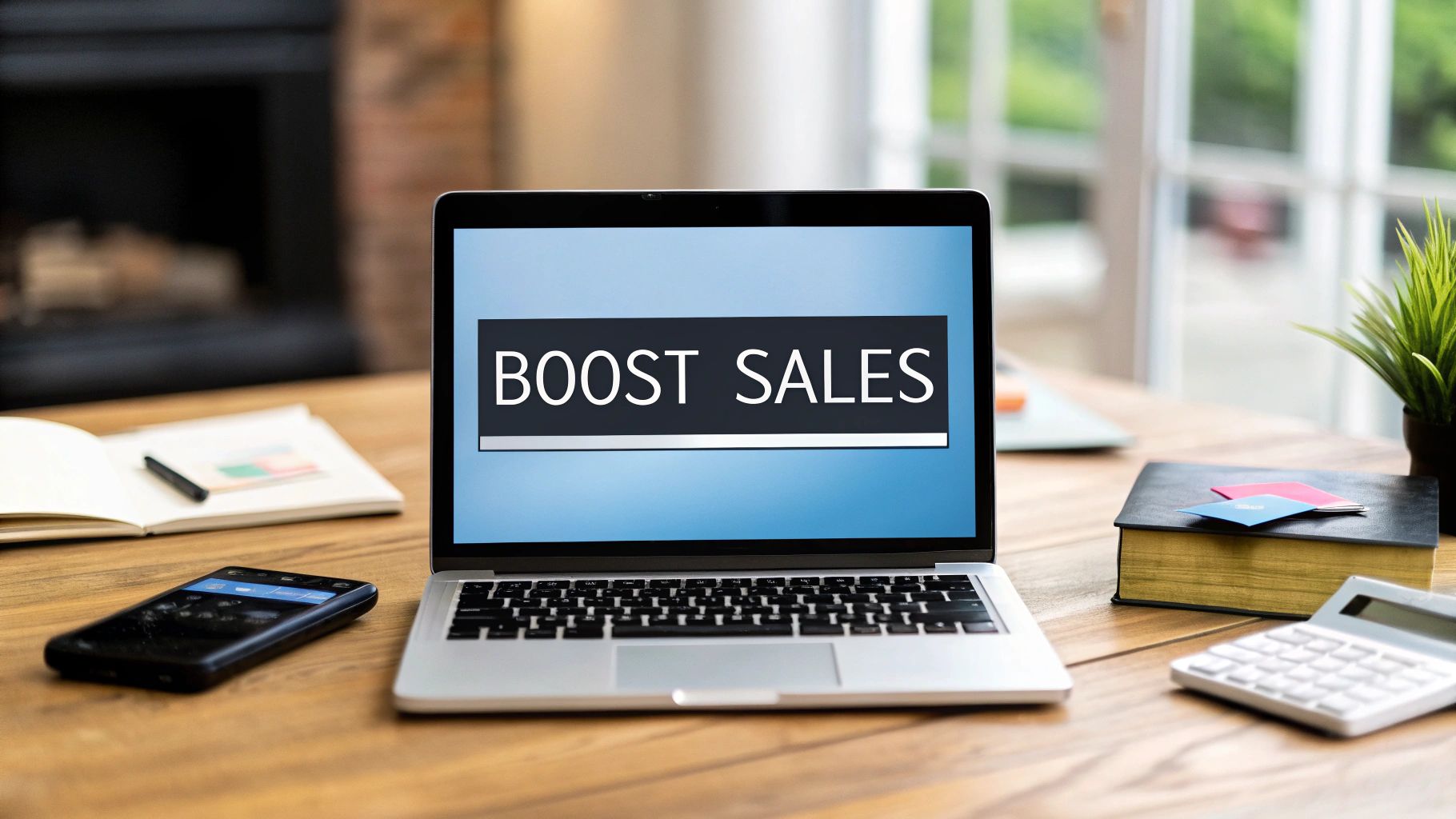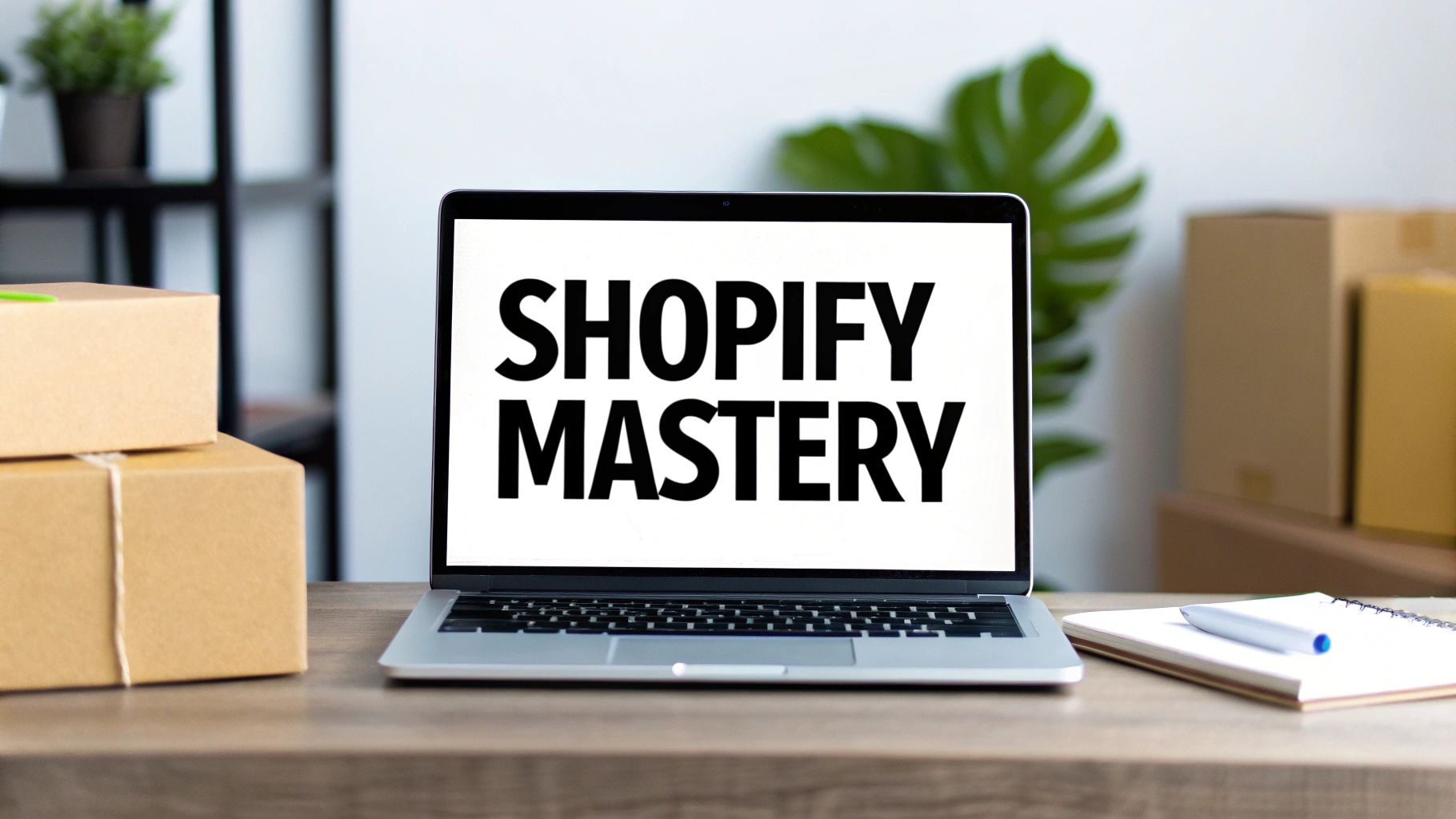10 Proven Ways to Drive Traffic to Shopify Store in 2025
March 31, 2025
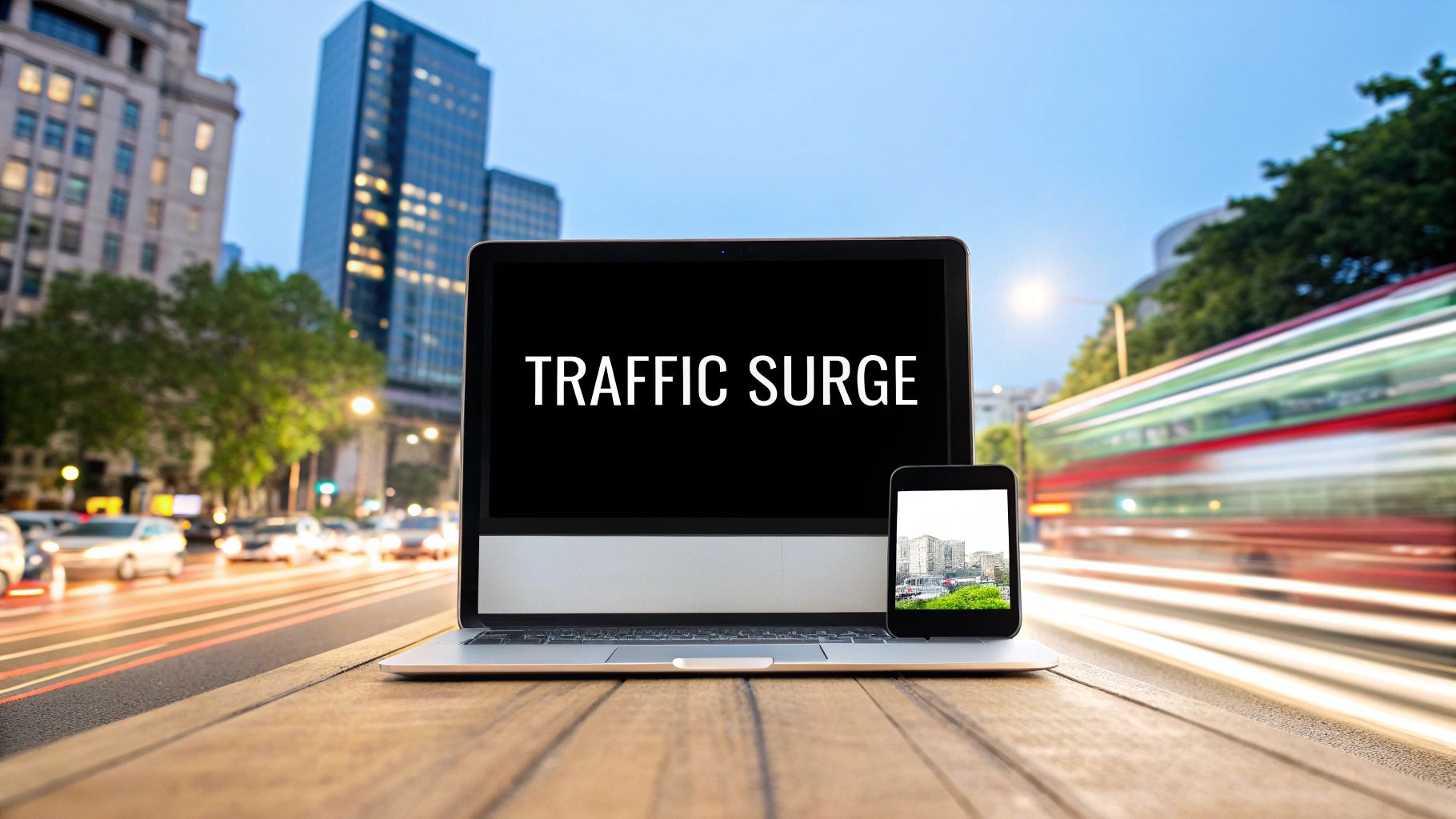
Unlocking Your Store's Potential: A 10-Point Traffic-Boosting Guide
Want more customers in your Shopify store? You're in the right place. Early e-commerce sites often attracted decent traffic just by existing. The online world has changed. Millions of stores compete for attention. Driving traffic isn't optional anymore—it's essential. This shift has led to new online marketing strategies. We've moved past simple banner ads to multi-channel approaches. These use the power of search engines, social media, valuable content, and smart partnerships.
What makes a modern traffic strategy work? Understanding your target audience is key. You need compelling content, placed where they’ll see it. It's about real connections, trust, and providing value. This guide reveals 10 powerful strategies based on these ideas. We’ll cover established marketing theory and newer techniques. Get ready to use proven methods. You’ll learn to optimize your store for search engines and use the power of influencers and partnerships. Transform your Shopify store into a busy online hub and reach its full potential.
1. Search Engine Optimization (SEO)
Make your store easily discoverable by search engines like Google. Use relevant keywords in your product descriptions and website content. This helps customers find your products when searching online.
2. Pay-Per-Click (PPC) Advertising
Invest in targeted advertising campaigns on platforms like Google Ads. PPC ads can quickly drive traffic to your store. You only pay when someone clicks on your ad.
3. Social Media Marketing
Engage with your target audience on social media platforms. Share engaging content, run contests, and build a community around your brand.
4. Content Marketing
Create valuable content, like blog posts and videos, that attracts and engages your target audience. Offer helpful information related to your products. This builds trust and establishes you as an expert.
5. Email Marketing
Build an email list and send targeted email campaigns to your subscribers. Promote new products, offer exclusive discounts, and keep your audience engaged.
6. Influencer Marketing
Partner with influencers in your niche to reach a wider audience. Influencers can promote your products to their followers, generating interest and sales.
7. Affiliate Marketing
Collaborate with other businesses or websites to promote your products. Affiliates earn a commission for every sale they generate, incentivizing them to drive traffic to your store.
8. Referral Programs
Encourage your existing customers to refer their friends and family to your store. Offer rewards or discounts for successful referrals, creating a powerful word-of-mouth marketing channel.
9. Community Building
Create a sense of community around your brand. Host online events, engage in relevant forums, and foster connections with your customers. This builds loyalty and encourages repeat business.
10. Analyze and Optimize
Continuously monitor your website traffic and analyze which strategies are most effective. Use data-driven insights to optimize your campaigns and maximize your return on investment.
1. Search Engine Optimization (SEO)
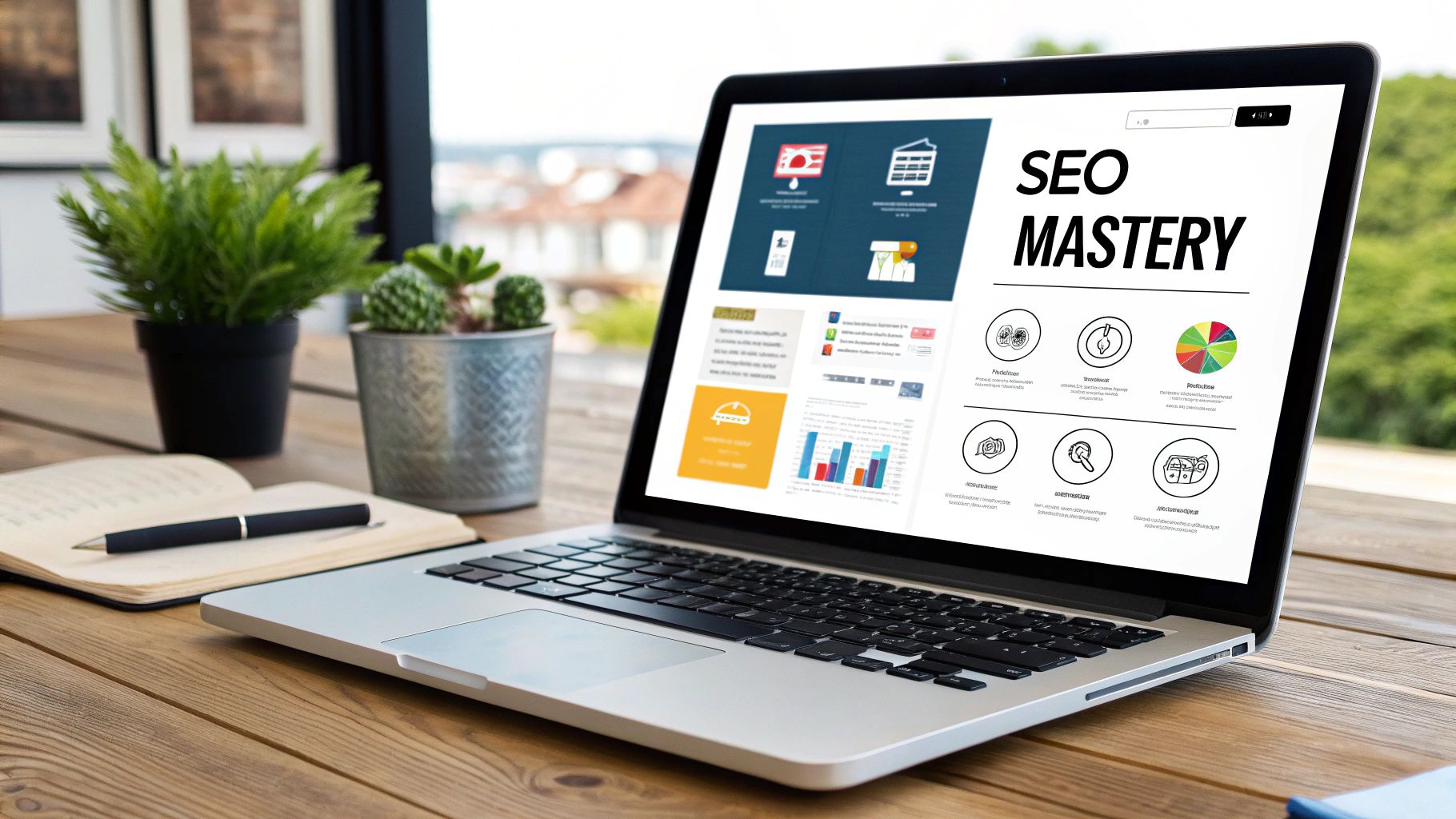
Search Engine Optimization (SEO) is the cornerstone of long-term, sustainable traffic for your Shopify store. It's all about optimizing your online store to rank higher in search engine results pages (SERPs), primarily Google, for relevant keywords. Instead of paying for every visit (like with ads), SEO focuses on earning free, organic traffic.
This deserves the top spot on our list because organic traffic is often more qualified. Users are actively searching for what you offer, leading to higher conversion rates and, ultimately, more sales.
SEO encompasses both on-page and off-page strategies. On-page optimization refers to elements within your Shopify store that you directly control.
On-Page Optimization
Here are some key on-page optimization elements:
- Keyword Research and Implementation: This involves identifying the terms your target audience uses and incorporating them into your website content.
- Optimizing Product Descriptions, Titles, and Meta Tags: Craft compelling and keyword-rich descriptions to inform search engines and attract customers.
- URL Optimization: Create clean, descriptive URLs that include relevant keywords.
- Image Alt Text: Add descriptive text to images to help search engines understand their context.
- Technical SEO: Ensure your website is technically sound, including fast page load speeds, mobile responsiveness, and proper schema markup.
Off-page SEO focuses on external factors that influence your rankings.
Off-Page Optimization
The most crucial aspect of off-page SEO is:
- Link Building: Earning high-quality backlinks from other reputable websites signals to search engines that your store is a trusted source.
SEO has gained immense popularity in ecommerce. Businesses are realizing the power of organic search. Brands like MVMT Watches, which grew to over $90 million in revenue, leveraged a strong SEO and content strategy.
Similarly, Beardbrand established itself as an industry authority by creating comprehensive and SEO-optimized content. Allbirds consistently ranks for sustainable footwear terms thanks to their targeted SEO efforts. These examples showcase SEO's potential to drive substantial growth.
Pros of SEO
- Long-term Sustainable Traffic: Organic traffic doesn't disappear when you stop paying, unlike paid ads.
- Higher Trust From Consumers: Users often view organic results as more credible.
- No Direct Cost Per Visitor: Organic traffic is essentially free, though it requires time and effort.
- Compounds Over Time: Consistent SEO efforts build upon each other, leading to increasing returns.
- Higher Conversion Rates: Organic traffic is typically more qualified.
Cons of SEO
- Takes Time to See Results: SEO is a marathon, not a sprint. Expect 3-6 months before seeing significant results.
- Requires Ongoing Maintenance: SEO is an ongoing process requiring regular updates.
- Algorithm Changes: Search engine algorithms can change, impacting rankings.
- Competitive Keywords: Ranking for highly competitive keywords can be challenging.
- Technical Knowledge: SEO can be technically complex and may require professional assistance.
Practical Tips For Shopify SEO
- Utilize Shopify SEO Apps: Apps like SEO Manager and Plug in SEO can help optimize your store.
- Craft Unique Product Descriptions: Write detailed, keyword-rich descriptions.
- Optimize Site Structure: Organize products into logical categories and collections.
- Improve Page Load Speed: Compress images and minimize code.
- Build a Blog: Create valuable content related to your products.
The rise of SEO in ecommerce can be attributed to industry leaders like Rand Fishkin, Neil Patel's ecommerce SEO guides, and tools like Ahrefs and SEMrush, which provide valuable resources. By implementing a solid SEO strategy, you can attract organic traffic, build brand authority, and achieve long-term growth for your Shopify store.
2. Social Media Marketing
Social media marketing is a powerful way to drive traffic to your Shopify store. Using platforms like Instagram, Facebook, TikTok, Pinterest, and Twitter helps build brand awareness, engage with potential customers, and ultimately, boost sales. This involves creating engaging content, building a community around your brand, and using platform-specific features to encourage store visits.
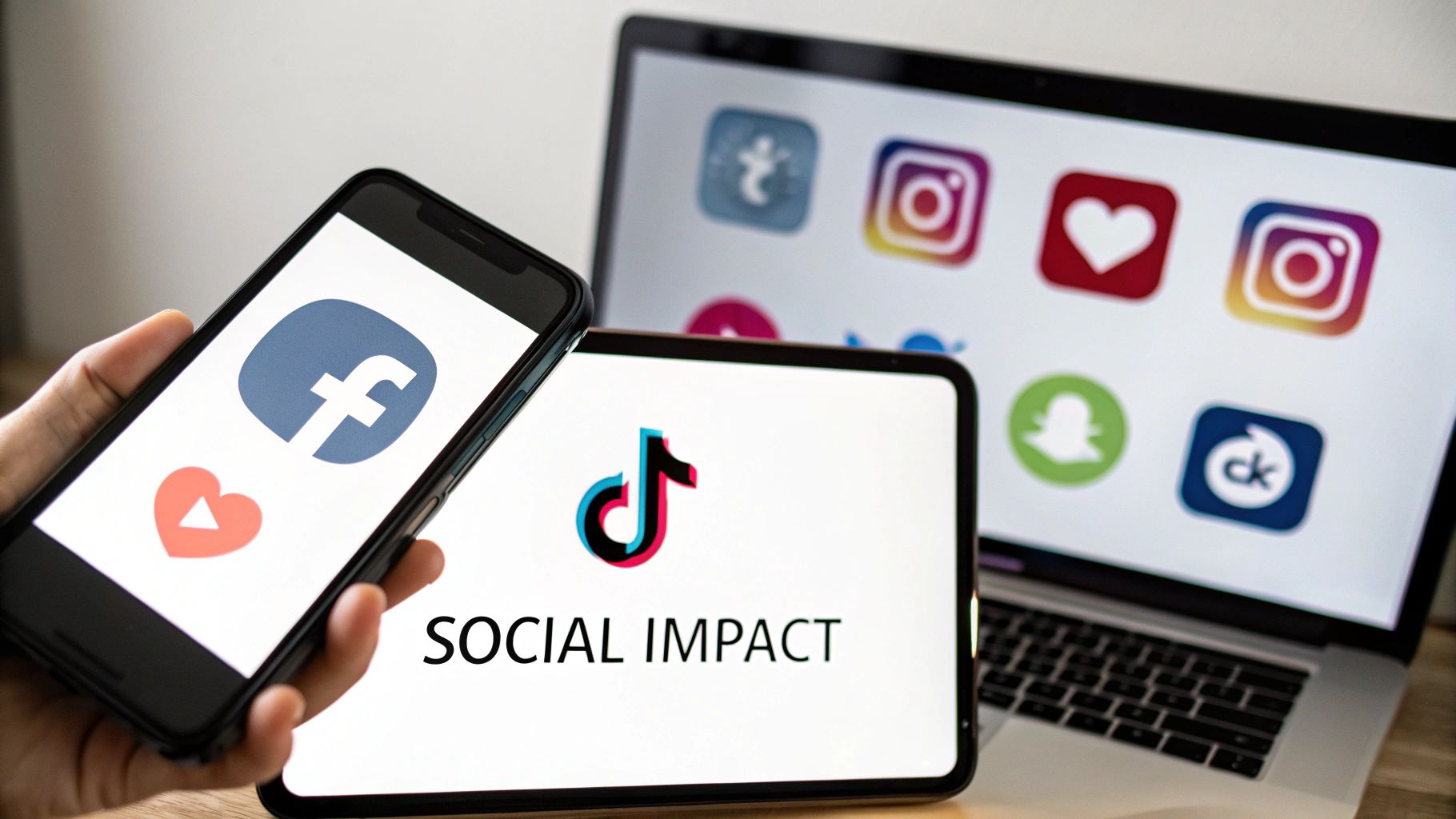
This strategy is highly effective due to its potential reach and ability to build lasting customer relationships. Features like shoppable posts with product tags, Stories, Reels, and short-form videos dynamically showcase products in real-life situations. Engaging with your audience and using trending hashtags builds brand personality and loyalty, and can even lead to viral content.
Think of success stories like Gymshark, which grew to a $1.3B valuation largely through Instagram influencer marketing. Fashion Nova built a massive following with user-generated content on the same platform. Even Kylie Cosmetics leveraged Snapchat and Instagram to become a billion-dollar brand.
One key benefit of social media marketing is direct engagement with potential customers. This fosters community and allows you to gather valuable feedback.
However, social media marketing does have challenges. Organic reach is declining, and the landscape is increasingly pay-to-play. It requires consistent content creation, and platform algorithm changes can impact visibility. Managing multiple platforms can be time-consuming, and tracking ROI from organic efforts can be tricky.
Pros:
- Access to massive user bases across platforms
- Visual product showcases in real-life contexts
- Direct engagement with potential customers
- Ability to build brand personality and loyalty
- Potential for viral content
Cons:
- Increasingly pay-to-play with declining organic reach
- Requires consistent content creation and posting
- Platform algorithm changes can affect visibility
- Time-intensive to manage multiple platforms
- Difficult to track direct ROI from organic efforts
Tips for Implementation:
- Focus: Choose 2-3 platforms where your target audience is most active.
- Consistency: Maintain a regular posting schedule with a content calendar.
- Authenticity: Build trust with user-generated content.
- Integration: Connect Instagram/Facebook shops to your Shopify store.
- Engagement: Respond to comments and messages promptly.
You might be interested in: How to Sell on Instagram with Shopify.
Social media marketing’s rise as a dominant force in e-commerce is thanks in part to figures like Gary Vaynerchuk and his emphasis on social media strategies. The success of Instagram-first brands like Daniel Wellington and TikTok-propelled brands like The Pink Stuff also demonstrate social media’s power to connect with audiences and drive business growth.
3. Paid Advertising (PPC)
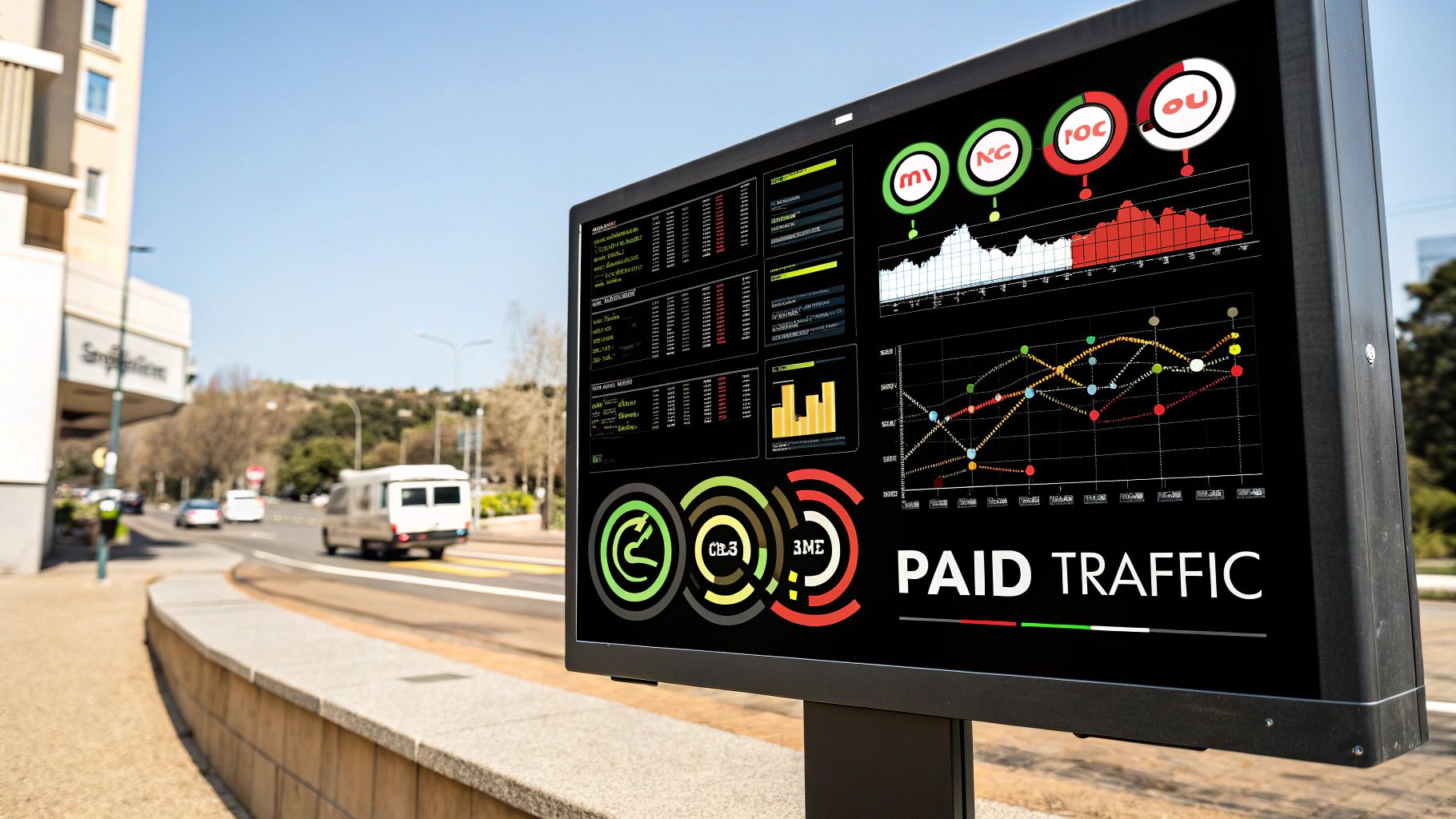
Paid advertising, also known as Pay-Per-Click (PPC), is a powerful tool for driving traffic to your Shopify store. It's a crucial strategy because it offers the most immediate and controllable way to put your products directly in front of potential customers. Unlike organic strategies that take time to gain traction, PPC delivers instant visibility.
Using platforms like Google Ads, Facebook/Instagram Ads, TikTok Ads, and Pinterest Ads, you can show highly targeted ads. These ads reach potential customers actively searching for products like yours or who fit a specific demographic and interest profile.
This strategy is particularly effective due to its precise targeting options. You can target audiences based on demographics, interests, and online behaviors. You can even retarget visitors who have already interacted with your store but haven't made a purchase. Dynamic product ads, which showcase items previously viewed by a user, are especially effective in re-engaging potential buyers.
Key Benefits and Features of PPC
- A/B testing: Experiment with different ad creatives and copy.
- Performance Tracking: Monitor your campaigns with robust analytics.
- Campaign Optimization Tools: Fine-tune your campaigns for maximum ROI.
These features provide clear benefits: immediate traffic, precise targeting, scalability (especially with profitable campaigns), detailed analytics and attribution data, and real-time budget control. Success stories are plentiful, with brands like BOOM by Cindy Joseph scaling to over $20 million through Facebook ads. ThirdLove disrupted established brands with detailed targeting on Facebook, and Snow Teeth Whitening leveraged Instagram ads for rapid growth. These examples highlight the potential of well-executed PPC campaigns.
Potential Downsides of PPC Advertising
However, PPC also has its challenges. The cost per acquisition (CPA) can be high, especially in competitive markets, requiring a consistent budget. Ad fatigue can also become an issue, requiring frequent creative updates. Platform changes, like Apple's iOS 14 update, can impact tracking and performance, adding another layer of complexity. Finally, mastering effective campaign management requires a learning curve.
Tips for PPC Success
To maximize your PPC success, consider these tips:
- Start with retargeting: These campaigns typically have lower CPAs.
- Develop a Facebook Pixel strategy: Use event tracking to optimize campaigns.
- Experiment with ad formats: Try single image, carousel, video, and collection ads.
- Use UTM parameters: Track traffic sources precisely.
A good practice is to allocate 70% of your budget to proven campaigns and 30% to testing new approaches. Experts like Ezra Firestone of Smart Marketer, Jon Loomer, and Common Thread Collective have popularized many of these strategies.
You might be interested in: Our guide on Shopify Conversion Optimization. Optimizing your conversion rates is crucial for maximizing your return on ad spend after driving traffic to your store. By understanding PPC's nuances—its features, benefits, and potential pitfalls—and implementing best practices, you can leverage its power to significantly boost traffic and sales for your Shopify store.
4. Email Marketing
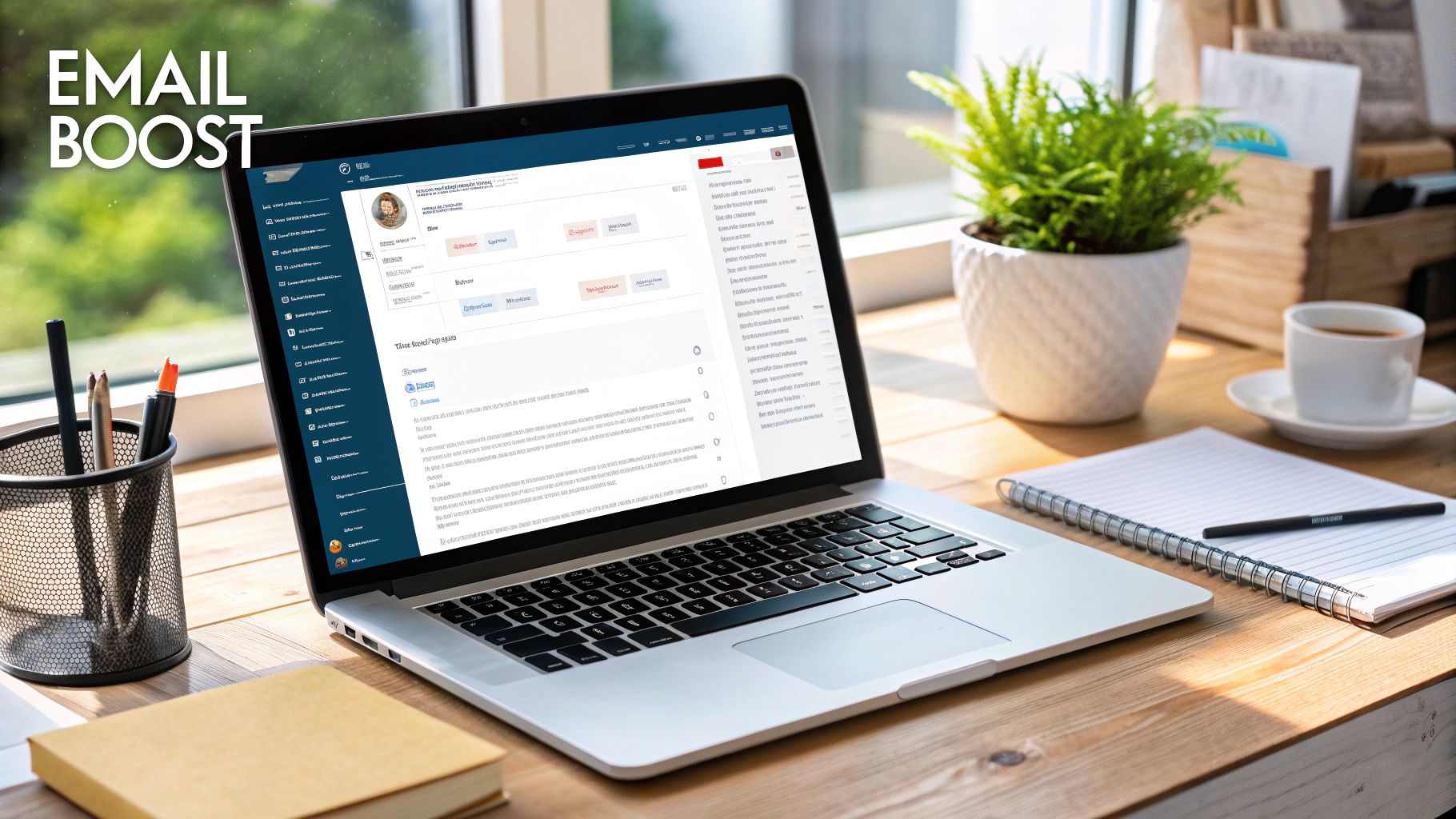
Email marketing is a crucial part of any successful Shopify store's traffic-driving strategy. It provides a direct connection to customers, allowing you to build relationships and encourage repeat business. Unlike platforms like social media, email lets you own your audience and communicate with them directly. This fosters loyalty and leads to sustainable growth.
Email marketing is all about growing a subscriber list and sending targeted campaigns to bring customers back to your store. It's not about sending out mass promotional emails. Instead, it's a strategic way to engage subscribers at every point in their buying journey.
How It Works & Why It Matters
Email marketing has come a long way. It’s no longer just about simple newsletters. Now, it’s a powerful marketing channel capable of personalized automation. Think automated welcome emails for new subscribers, abandoned cart reminders, post-purchase follow-ups, and product recommendations tailored to individual browsing history. This kind of personalized touch strengthens customer relationships and boosts sales.
Key Features & Benefits
- List Building: Expand your subscriber list with pop-ups, lead magnets (like discount codes or special content), and embedded signup forms.
- Segmentation: Group your audience by demographics, purchase history, or behavior to send highly relevant emails that get noticed.
- Automation: Create automated email sequences (welcome series, abandoned cart reminders, post-purchase thank you notes) to engage subscribers without constant manual work.
- Promotional Campaigns: Share sales, new products, and special offers directly with your engaged audience.
- Personalization: Customize email content using individual subscriber data to make it more engaging and relevant.
Pros & Cons
Pros:
- Ownership: Control your customer data and avoid being affected by algorithm changes on other platforms.
- High ROI: Email marketing delivers an average return on investment (ROI) of 42:1.
- Segmentation & Personalization: Send the right message, to the right person, at the right time.
- Automation: Automated sequences work around the clock, nurturing leads and driving sales even when you're not working.
- Direct Attribution: Easily track how effective your campaigns are and link sales back to specific emails.
Cons:
- List Building Takes Time: Building a substantial subscriber list takes time and effort.
- Deliverability Challenges: Managing spam filters and keeping good email deliverability requires continuous work.
- Subscriber Fatigue: Sending too many emails can lead to people unsubscribing.
- Content Creation: Running regular campaigns means you need to consistently create fresh content.
- Inbox Competition: Your emails have to stand out in crowded inboxes.
Real-World Examples
- Brooklinen: Uses targeted campaigns based on past purchases, suggesting related products and offering personalized discounts.
- Who Gives A Crap: Uses humor and compelling storytelling to build brand loyalty and drive sales.
- Casper: Their regular, sleep-focused content offers valuable information and subtly encourages subscribers to return to their website.
Practical Tips for Implementation
- Use dedicated email marketing platforms: Klaviyo or Omnisend are specifically designed for e-commerce email marketing.
- Implement exit-intent popups: Collect email addresses from visitors about to leave your site with a discount or other incentive.
- Create automated flows: Set up automated email sequences for welcome series, abandoned carts, and win-back campaigns.
- Segment your audience: Group your subscribers based on buying history, engagement, and interests.
- A/B test: Test different subject lines, send times, and email layouts to improve open and click-through rates.
Popularized By
Email marketing’s success for e-commerce has been promoted by experts like Chase Dimond, whose strategies concentrate on maximizing ROI and customer lifetime value. Platforms like Klaviyo have also played a major role, providing strong tools built for online stores. Brands like Harry's, which relied heavily on email to build their early customer base, demonstrate email's potential.
5. Influencer Marketing
Influencer marketing has become a powerful tool for driving traffic and increasing sales. It's now a core strategy for many Shopify stores. It involves collaborating with social media personalities who have a dedicated following to promote your products. These partnerships can range from simple sponsored posts to long-term brand ambassador relationships. Essentially, you're using the trust and influence these individuals have with their audience to generate interest and direct traffic to your Shopify store.
This strategy offers several options:
- Micro, mid-tier, and macro influencer partnerships: These cater to different budgets and reach goals.
- Product seeding campaigns: Send free products to influencers for organic reviews and mentions.
- Affiliate marketing programs with custom codes: Track sales from specific influencers and reward them accordingly. Consider using a platform like AffiliateWP to manage your program.
- Sponsored posts and content collaborations: Work with influencers to create engaging content that showcases your products.
- Takeovers of brand social accounts: Allow influencers temporary control of your social media channels for greater visibility.
These collaborations offer many benefits:
- Leverages established trust: Influencers have strong relationships with their followers, who trust their recommendations.
- Provides social proof: Third-party endorsements add legitimacy to your brand and products.
- Creates ready-to-use content: You can repurpose influencer-generated content on your own channels.
- Reaches highly targeted niche audiences: Working with the right influencers allows you to connect with your ideal customers.
- Can generate significant traffic spikes during campaigns: Well-executed campaigns can bring a surge of visitors to your store.
However, influencer marketing also presents some challenges:
- Can be expensive: Costs can be high, particularly when working with macro-influencers who have large followings.
- Results can be unpredictable: Measuring the return on investment (ROI) of influencer campaigns can be difficult.
- Potential audience mismatch: If you don't carefully vet influencers, their audience may not align with your target market.
- Influencer authenticity concerns: Consumers are becoming more discerning and can recognize inauthentic partnerships.
- Managing multiple influencer relationships can be time-consuming: This requires ongoing communication and coordination.
Real-World Examples of Influencer Marketing Success
Real-world examples demonstrate the impact of influencer marketing. Fashion Nova’s rapid growth is largely due to extensive Instagram influencer collaborations. MVMT Watches used YouTube influencers to showcase product quality and build brand awareness. Morphe Cosmetics partnered with makeup artist influencers, leading to substantial growth and establishing them as a key player in the beauty industry.
The rise of influencer marketing can be linked to campaigns like Daniel Wellington’s #DWPickoftheDay, which encouraged users to share photos of their watches. Similarly, beauty influencers like James Charles have been instrumental in promoting various makeup brands. GymShark’s athlete program, featuring fitness influencers, is another great example of successful influencer marketing.
Tips For Effective Influencer Marketing
- Focus on engagement rates over follower count: A smaller, engaged audience is often more valuable than a large, passive one.
- Create unique tracking links or discount codes: This helps accurately attribute sales and measure campaign performance.
- Provide clear briefs while allowing creative freedom: Guide influencers while still respecting their individual style and voice.
- Consider micro-influencers (10K-50K followers): They often offer better engagement at lower costs.
- Build long-term relationships rather than one-off promotions: Foster genuine partnerships for a sustained impact. Consider creating detailed Brand Guidelines for Social Media to ensure consistency.
By understanding the complexities of influencer marketing and using these tips, you can effectively use this strategy to drive traffic and increase sales for your Shopify store.
6. Content Marketing: Build a Loyal Audience and Drive Sustainable Traffic
Content marketing is more than just writing blog posts. It's a strategic approach to building a loyal audience and driving sustainable traffic to your Shopify store. By creating and sharing valuable, relevant content, you attract, engage, and retain potential customers, subtly guiding them through the sales funnel. It deserves a prominent place in your Shopify marketing strategy because it fosters long-term growth and establishes your brand as an authority in your niche.
Instead of directly promoting your products, content marketing focuses on providing information that addresses your target audience's questions, pain points, and interests. Think of it as building a relationship with your customers before they even make a purchase. This approach fosters trust and positions your store as a go-to resource, making customers more likely to choose you when they're ready to buy.
How Does Content Marketing Work for Shopify?
Content marketing for Shopify can take many forms:
-
Blog Content Optimized for SEO: Attract organic traffic by creating blog posts that target relevant keywords your customers are searching for. Optimize titles, descriptions, and content for search engines like Google to improve visibility.
-
Educational Videos Demonstrating Product Use: Videos are engaging and can effectively demonstrate the value and functionality of your products. Consider creating tutorials, reviews, or behind-the-scenes glimpses of your production process. You can host your videos on platforms like YouTube.
-
Buying Guides and Comparison Content: Help customers make informed decisions by creating comprehensive buying guides and comparing different products. This positions you as a helpful resource and can drive conversions.
-
User-Generated Content Campaigns: Encourage customers to create and share content related to your brand. This builds social proof and expands your reach.
-
Interactive Tools and Quizzes: Engage your audience with interactive content that helps them discover products or learn more about your brand in a fun and engaging way.
Real-World Examples
Several brands illustrate successful content marketing:
-
Beardbrand (beardbrand.com): Their extensive beard care guides and YouTube channel offer valuable advice, building a community and driving sales.
-
Patagonia (patagonia.com): Their environmental activism content aligns with their brand values, attracting a loyal customer base that shares their concerns.
-
Glossier (glossier.com): Their blog, Into The Gloss, preceded and continues to support their product line, building anticipation and creating a dedicated following.
Pros & Cons of Content Marketing
Here's a quick look at the advantages and disadvantages:
| Pros | Cons |
|---|---|
| Builds authority and trust | Requires significant time investment |
| Creates multiple entry points to your store | Needs a consistent content creation schedule |
| Long-lasting traffic source | May require specialized knowledge or writers |
| Educates customers | Difficult to directly attribute sales |
| Can be repurposed across multiple channels | Oversaturated topics may be challenging to rank for |
Tips for Implementation
Here are a few tips to get you started:
-
Research: Understand your target audience's questions and pain points. Tools like AnswerThePublic can help.
-
Target the Buying Funnel: Create content for different stages, from awareness to decision.
-
Shopify Blog or WordPress: Use the built-in Shopify blog or integrate a more robust solution like WordPress.
-
Internal Linking: Link to relevant product pages within your content.
-
Content Calendar: Plan and schedule your content to maintain consistency.
Evolution and Popularization
The Content Marketing Institute has played a crucial role in defining and popularizing content marketing methodologies. Brands like REI, with their expert advice section, and Buffer, with their content-first approach, have demonstrated the effectiveness of content marketing in driving business growth.
By implementing a well-planned content marketing strategy, you can build a sustainable, engaged audience, establish your brand as a leader in your niche, and ultimately, drive more traffic and sales to your Shopify store.
7. Pinterest Marketing
Pinterest isn't just another social media platform. It's a visual search engine where users look for ideas and inspiration, often with shopping in mind. This makes Pinterest a powerful tool for directing traffic to your Shopify store, especially for businesses in specific niches. The combination of social networking and product discovery makes it particularly valuable for eCommerce.
Why should Pinterest be part of your Shopify marketing strategy? With 89% of users in a buying mindset, Pinterest offers a highly engaged audience ready to make purchases. Unlike other social media posts, Pins have a long lifespan, continuing to drive traffic for weeks, months, or even years. This makes it a sustainable traffic source for long-term growth.
How to Leverage Pinterest for Your Shopify Store
Pinterest marketing is all about visually showcasing your products through Pins that link directly to your product pages. This creates a simple path to purchase, streamlining the customer journey. Here's a breakdown:
- Shoppable Pins: These Pins display product information like price and availability, letting users buy directly on Pinterest.
- Rich Pins: These Pins automatically update with any website changes, ensuring accuracy of pricing and availability.
- Pinterest SEO: Optimize your boards and Pin descriptions with relevant keywords to enhance visibility in Pinterest search results. Think of your boards as categories and your Pins as product pages.
- Pinterest Advertising: Increase your reach with Promoted Pins, targeting specific demographics and interests.
- Catalog Integration: Create product Pins automatically from your Shopify catalog, saving you time and keeping your Pinterest presence current.
Pros and Cons of Pinterest Marketing
- Pros: High purchase intent, long lifespan of Pins, visual discovery, strong female demographic, sustained traffic generation.
- Cons: Niche-specific (best for home decor, fashion, beauty, DIY), requires consistent effort to build a following, needs high-quality vertical images (2:3 ratio), less effective for male-targeted products, slower organic traffic growth compared to paid advertising.
Real-World Examples of Successful Pinterest Marketing
- Wayfair: Expertly utilizes themed boards and shoppable Pins to showcase their furniture and home decor catalog, driving significant website traffic.
- Etsy Sellers: Pinterest helps Etsy sellers emphasize the unique, handmade nature of their products, connecting them with craft enthusiasts.
- Tasty (BuzzFeed): Uses Pinterest to drive traffic to recipe-related products and kitchenware, demonstrating the platform's versatility.
Practical Tips for Implementing Pinterest Marketing
- Business Account & Rich Pins: Set up a Pinterest business account and enable Rich Pins for automatic product updates.
- Targeted Boards: Create at least 10-15 boards related to your niche, organizing your Pins for easy browsing.
- Consistent Pinning: Pin regularly (10-25 Pins daily) using a scheduling tool like Tailwind to maximize reach and engagement.
- Group Boards: Join relevant group boards to expand your audience and introduce your products to new potential customers.
- Pinterest SEO: Use keywords in your Pin descriptions and board titles to improve search visibility.
The Growth of Pinterest Marketing
Pinterest marketing grew in popularity with the rise of visual content and influencer marketing. Experts like Melyssa Griffin helped popularize effective strategies for the platform. Tools like Tailwind emerged to simplify and automate Pinterest marketing. Brands like Anthropologie, with their visually appealing aesthetic, demonstrate the potential of a strong Pinterest presence.
By understanding Pinterest’s strengths and using these practical tips, you can effectively use Pinterest marketing to drive targeted traffic and increase sales for your Shopify store.
8. Referral and Affiliate Programs
Referral and affiliate programs are powerful tools for driving targeted traffic to your Shopify store. They incentivize others to spread the word about your products, essentially turning satisfied customers and motivated marketers into an extension of your sales team. This leverages their existing networks and platforms to reach new audiences. It’s often a more organic and cost-effective approach than traditional advertising.
How Referral and Affiliate Programs Work
The core concept is simple: reward people for bringing you customers. Referral programs focus on existing customers, encouraging them to recommend your store to their friends and family. Affiliate programs, on the other hand, target third-party marketers (bloggers, influencers, etc.) who promote your products to their audience. They receive a commission on each sale generated through their efforts.
Features and Benefits
Here's a breakdown of some key features and benefits:
- Customer Referral Programs: Offer dual-sided rewards. Both the referrer and the referred customer receive a discount, store credit, or a free gift. This encourages word-of-mouth marketing and repeat purchases.
- Affiliate Marketing Programs: Utilize commission structures, typically a percentage of the sale generated through the affiliate's unique tracking link.
- Tracking & Management: Robust platforms provide tools for tracking referrals, attributing sales, and managing payouts.
- Marketing Materials: Equipping affiliates with pre-made banners, creatives, and product information streamlines their promotional efforts.
- Tiered Commission Structures: Motivate affiliates by offering increasing commission rates as they drive more sales.
Pros
- Lower Customer Acquisition Costs: Compared to paid advertising, referral and affiliate marketing can significantly reduce the cost of acquiring new customers.
- Higher Trust Factor: Recommendations from trusted sources carry more weight than traditional advertising, leading to higher conversion rates.
- Performance-Based Payment: You only pay when a sale is made, minimizing risk and maximizing ROI.
- Extended Reach: Tap into new audiences through the networks of your customers and affiliates.
- Encourages Repeat Purchases: Referral rewards can incentivize existing customers to come back for more.
Cons
- Management Overhead: Setting up and managing these programs requires time and effort.
- Potential for Fraud: Affiliate marketing can be susceptible to fraudulent activities or policy violations.
- Competitive Commission Rates: Attracting quality affiliates in competitive niches may require offering competitive commission rates.
- Affiliate Recruitment: Building a strong affiliate network takes time and effort.
- Technical Integration: Integrating referral and affiliate software with your Shopify store requires some technical setup.
Real-World Examples
- Rothy's: Offers a $20 credit for both the referrer and referee.
- Girlfriend Collective: Generated buzz with a viral referral campaign offering free leggings.
- Allbirds: Connects their refer-a-friend program to their sustainability mission, resonating with their target audience.
- Dropbox: Their iconic referral program fueled explosive growth, adding millions of users through incentivized sharing. This is a classic example of how powerful referral marketing can be.
- Amazon Associates: One of the largest and most successful affiliate programs globally, demonstrating the scalability of this model.
Tips for Implementation
- Utilize Apps: Simplify setup and management by using Shopify apps like ReferralCandy or Smile.io for customer referrals, and Refersion, AvantLink, or ShareASale for affiliate programs.
- Tiered Commissions: Reward top performers with higher commission rates to incentivize increased promotion.
- Provide Marketing Materials: Equip affiliates with ready-to-use creatives, tracking links, and product information.
- Clear Communication: Clearly outline program terms, conditions, and payout schedules.
Why Referral and Affiliate Programs Deserve a Spot on the List
These programs offer a unique blend of organic reach, cost-effectiveness, and scalability. By leveraging the power of word-of-mouth marketing and strategic partnerships, you can unlock sustainable growth and build a loyal customer base. They deserve a place on this list because they represent a proven strategy for driving targeted traffic and increasing sales for Shopify stores.
9. Collaborations and Partnerships
Collaborations and partnerships offer a powerful way to expand your reach and boost traffic to your Shopify store. By connecting with complementary brands, retailers, or even communities, you can tap into new customer bases and create exciting joint marketing initiatives. Think co-branded products or cross-promotional campaigns. Leveraging your partners' established audiences and credibility can significantly increase your brand visibility and bring in a wave of new customers.
Why Collaborations Are Key
In the competitive world of e-commerce, standing out is essential. Collaborations provide a unique avenue to differentiate your brand, generate buzz, and access pre-built audiences. This makes them a valuable strategy for boosting Shopify traffic. It's a mutually beneficial arrangement where both partners gain increased exposure and potential revenue.
Exploring Collaboration Options
Collaborations offer a flexible approach to reaching new customers, taking on various forms:
-
Co-branded Products: Partnering to create unique products generates excitement and appeals to both audiences. Imagine the possibilities!
-
Cross-Promotional Emails: Leverage each other's email lists to introduce your brand to a larger pool of potential customers.
-
Joint Content Creation: Creating valuable content together, whether it's blogs, webinars, or podcasts, establishes authority and reaches a wider audience.
-
Marketplace or Retailer Partnerships: Expand your distribution channels by selling through established marketplaces or partnering with complementary retailers.
-
Community or Cause-Based Partnerships: Aligning with a shared cause strengthens your brand image and connects with socially conscious consumers.
Real-World Success Stories
-
Supreme x Louis Vuitton: This high-fashion partnership created massive hype and drove incredible traffic and sales, demonstrating the power of combining distinct brand identities.
-
Glossier x Bark: Combining beauty and pet products, this collaboration reached new customers in both markets with a quirky, co-branded dog toy.
-
Warby Parker x Arby's (WArby's): This unexpected April Fool's Day collaboration, featuring comically oversized glasses and food-themed eyewear, went viral, generating significant brand awareness.
Weighing the Pros and Cons
Pros:
- Immediate access to established, relevant audiences
- Shared marketing costs and resources
- Enhanced brand credibility through association
- Creative differentiation through unique partnerships
- Potential for press coverage and PR opportunities
Cons:
- Finding suitable partners can require time and effort
- Negotiation and clear agreements on terms are crucial
- Brand reputation is at risk if the partner faces issues
- Coordination challenges can arise across different organizations
- Revenue sharing may impact profit margins
The Evolution of Collaboration
Supreme's partnerships with unexpected brands like Louis Vuitton popularized high-low collaborations, showcasing the potential for generating buzz and driving sales. Shopify's own "Collaborations" feature simplifies the process for merchants, making it easier to connect and partner with other businesses. Target's ongoing designer collaborations consistently drive traffic to their stores, demonstrating the long-term effectiveness of this strategy.
Tips for Successful Collaborations
-
Target Similar Audiences: Identify brands with similar target audiences but non-competing products.
-
Start Small: Begin with small, low-risk collaborations to test partnership compatibility.
-
Create Exclusive Offers: Develop exclusive offers or limited-edition products to drive urgency.
-
Clear Agreements: Establish clear agreements on traffic attribution and revenue sharing.
-
Maximize Exposure: Leverage both parties' marketing channels for maximum reach.
By carefully selecting partners and developing compelling joint initiatives, collaborations can effectively drive targeted traffic to your Shopify store and fuel significant growth.
10. PR and Media Outreach
PR and media outreach offer a powerful way to boost your Shopify store's visibility and drive targeted traffic. It's all about strategically getting your brand featured in relevant publications, blogs, podcasts, and news outlets. Instead of paying for ads, you're earning attention. You do this by providing valuable content and stories journalists and content creators want to share. This approach can lead to significant, long-term traffic growth, fueled by the credibility of established media sources.
How PR and Media Outreach Works
The core of PR and media outreach is creating newsworthy narratives. These narratives can revolve around your products, brand story, or company milestones.
- Media Pitch Development and Distribution: This involves crafting compelling pitches tailored to specific journalists and publications. Highlight why your story is relevant to their audience.
- Press Release Creation for Company News: Announce significant updates, product launches, or partnerships through official press releases. Distribute these releases to various media outlets.
- Product Seeding to Journalists and Reviewers: Send free samples of your products to influential voices in your niche. Encourage them to review and feature your products.
- HARO (Help A Reporter Out) Participation: HARO lets you respond to journalist queries, offering yourself as a source for articles they're working on.
- Media Relationship Building and Maintenance: Cultivate relationships with journalists and content creators through ongoing engagement and communication.
Real-World Examples of Successful PR
Several brands have successfully used PR to drive significant growth.
- Casper: Their innovative approach to mattress shopping generated extensive media coverage. Features like online ordering and free returns helped establish them as an industry leader.
- Away: This luggage brand gained prominence through strategic product placement. They were featured in gift guides and travel articles across major publications.
- The Ordinary: Their science-backed skincare and affordable pricing attracted beauty editors. This led to widespread media coverage and rapid growth.
Pros and Cons of PR
Pros:
- Third-Party Credibility: Coverage from established publications lends credibility to your brand.
- Potential for Significant Traffic Spikes: Feature articles can drive large volumes of targeted traffic.
- SEO Benefits: Backlinks from high-authority sites improve your search engine rankings.
- Brand Perception Enhancement: Media association enhances your brand image and perceived value.
- Long-Term Visibility: Articles remain online indefinitely, providing ongoing exposure.
Cons:
- Unpredictable Results: Securing media coverage isn't guaranteed, and results can vary.
- Requires Newsworthy Angles: You need compelling stories to capture media attention.
- Time-Intensive: Pitching and follow-up require significant time and effort.
- May Require Professional Assistance: Hiring a PR agency can improve results but adds cost.
- Limited Control over Content: You have limited control over the final published content.
Tips for Implementing PR
- Craft a Compelling Brand Story: Develop a narrative that resonates with your target audience. Make sure it aligns with publication themes.
- Research Media Outlets and Journalists: Identify relevant publications and journalists covering your niche.
- Build Relationships: Engage with journalists on social media before pitching.
- Time Pitches Strategically: Align pitches with relevant seasons, trends, or events.
- Provide High-Quality Media Kits: Include high-resolution images and product samples.
Evolution and Popularization of PR
Platforms like HARO have streamlined the process of connecting sources with journalists. Product Hunt launches also provide a platform for tech products to gain early traction and media coverage.
By strategically crafting compelling stories and building relationships, PR and media outreach can be highly effective. This approach can drive targeted traffic to your Shopify store and establish your brand as an industry leader.
Top 10 Shopify Traffic Strategies Comparison
| Strategy | Implementation Complexity (🔄) | Resource Requirements (⚡) | Expected Outcomes (📊) | Ideal Use Cases (💡) | Key Advantages (⭐) |
|---|---|---|---|---|---|
| Search Engine Optimization | Moderate-High; requires technical upkeep and continuous updates | Skilled professionals & ongoing maintenance effort | Long-term, sustainable organic traffic | Stores focused on building authority through content | Non-paid traffic; increased trust; compounding benefits |
| Social Media Marketing | Moderate-High; constant content creation and engagement management | Time-intensive; creative asset production | Enhanced brand engagement with potential viral spikes | Visual-centric brands & lifestyle products | Broad reach; direct engagement; strong brand personality |
| Paid Advertising (PPC) | Moderate; demands expertise in continuous testing and optimization | Significant budget and data-driven campaign management | Immediate traffic generation with scalable results | Campaigns needing quick impact and controlled spending | Precise targeting; measurable ROI; real-time adjustments |
| Email Marketing | Moderate; easier with automation tools but requires list building | Email platforms and content creation | High ROI; improved customer retention & direct conversions | Nurturing existing customers and driving repeat sales | Direct communication; automation efficiency; high personalization |
| Influencer Marketing | Moderate-High; involves negotiation and vetting influencers | Budget for partnerships and relationship management | Traffic spikes and social proof through endorsements | Lifestyle, fashion, and beauty niches | Leverages influencer trust; ready-to-use content; authentic reach |
| Content Marketing | High; requires constant production and SEO focus | Skilled writers and investment in content creation tools | Long-lasting traffic and enhanced authority | Niche sectors and educational content strategies | Authority building; evergreen content; multi-channel distribution |
| Pinterest Marketing | Low-Moderate; scheduled pinning simplifies workflow | Creative design skills and consistent posting | Sustainable, long-life traffic with high user purchase intent | Visual products such as home decor, fashion, DIY | Extended post lifespan; high buyer intent; visual discovery |
| Referral & Affiliate Programs | Moderate; needs proper setup and ongoing partner management | Setup tools and affiliate management platforms | Cost-effective, performance-based customer acquisition | Businesses with loyal customers seeking word-of-mouth referrals | Trust-driven; performance-based; scalable outreach |
| Collaborations & Partnerships | High; involves negotiation, coordination, and clear agreements | Joint marketing efforts and resource sharing | Instant access to new, relevant audiences | Co-branded initiatives and complementary product niches | Shared costs; enhanced credibility; creative differentiation |
| PR & Media Outreach | High; time-intensive pitching and relationship building | PR expertise and dedicated outreach tools | Significant traffic spikes from media features | Newsworthy launches, brand stories, and product announcements | Third-party credibility; SEO benefits; long-term visibility |
Ready to Rev Up Your Shopify Store's Traffic?
Driving traffic to your Shopify store isn't a one-size-fits-all approach. We've explored ten powerful strategies, from SEO and social media marketing to influencer collaborations and PR outreach. The main takeaway is to experiment, track your results, and focus on the tactics that best connect with your target audience.
Remember that SEO builds long-term organic visibility, while paid ads offer a faster boost. Social media helps build community, and email marketing nurtures leads.
Content marketing, Pinterest, referrals, collaborations, and PR all contribute to a comprehensive and effective traffic-driving strategy. By diversifying your approach, you're more likely to reach a wider audience.
Putting these concepts into action means knowing your audience. Who are they? Where do they spend their time online? What content do they find engaging? Adapting your strategy to your specific audience is critical.
Keeping Up With the Changing Online Landscape
The online world is always changing. Stay informed about new trends in social media algorithms, SEO best practices, and advertising platforms. Be flexible and prepared to adjust your strategies as needed. Continuous learning and experimentation are key for long-term success.
Boost Your Shopify Traffic With LinkShop
Ready to make your traffic-driving efforts more effective and build an impressive, shoppable online presence? LinkShop is the ultimate link in bio app made for Shopify merchants. Create attractive, shoppable link in bio pages that direct traffic to your products and increase your sales. It's more robust than LinkPop and seamlessly integrates with your Shopify store. Take your Shopify traffic to the next level with LinkShop today! Check out LinkShop

